![]()
PLATFORM > CONTENT CREATION TOOLS
One of the goals of the Interbots Initiative has been the creation of content authoring tools that are so intuitive and easy to use that they require no prior programming or technical skills. In order to accomplish this, we have leveraged the power of both popular, mass market software packages as well as custom proprietary graphical authoring tools. The following utilities make up our content creation suite.
BAT
One of the great strengths of the Interbots Platform is the Behavior Authoring Tool (BAT). Used to author content prior to run-time, BAT is an application for composing networks of superstates and substates (see the description of CSCS). BAT provides an intuitive graphical interface to manipulate the data in the behavior database, allowing non-programmers to easily create character personalities and script all character behaviors. Currently BAT is an application written in Macromedia Flash that interfaces with the character database by posting SQL commands through an ODBC-PHP connection. BAT provides a visualization of each superstate, making it easy to understand the complete picture of a character's personality. BAT also allows one to take over 40 factors into account for every decision the character will make, as well as to mix and match bits and pieces of animations that can be combined in real time by RSCS, the runtime playback system. To date, BAT has been used by numerous students in the Building Virtual Worlds Course to author behaviors and personalities for Quasi.
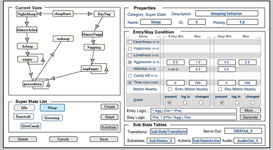 |
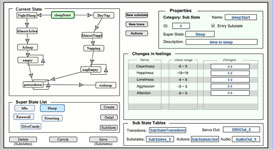 |
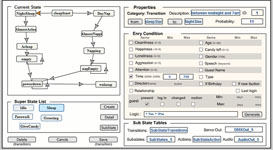 |
Maya Plug-in/Animation Editor Tool
Alias Maya is the industry standard application for 3D modeling, animation, and effects, used by professionals and students alike. It seemed the natural choice for opening up animation of the animatronic characters to 3D animators. To this end, we created a pipeline for exporting animations from Maya to the physical robot. Moreover, the pipeline is not limited to merely joint rotations, but can also control light levels and colors, within both the figure and its environment. In fact, anything that can be controlled by DMX can be easily added to the pipeline, provided it can be tied to some keyable attribute in Maya.
A template model of the character being controlled (in our case, Quasi) is provided for a 3D animator to work with. The file is animated in the same way as one would for onscreen results, but keeping in mind that the resulting output will be played back on a physical piece of hardware. A limit tester parses the file for warnings of any bits of animation that may be too extreme for the hardware to handle. The Animation Editor Tool (AET) also provides an easy to use slider and keyframe interface for those not comfortable with animating in Maya, as well as a lighting animation tool that is currently under development. The Maya Plug-in and AET output a file containing DMX signal values for selected servos. As the file is read by the RSCS application, the signal values are sequentially sent to the servos, animating the character in a lifelike manner
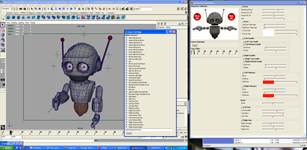 |
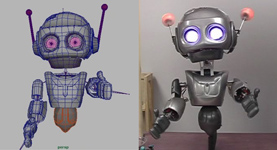 |
Director Touchscreen Framework
One of the most powerful means of interacting with Quasi resides in Macromedia Director, the popular tool for authoring multimedia content. It comes with a powerful scripting language and support for many media types, and its graphic abilities provide a perfect means for visualizing material. Splash screens, touch screen interfaces, video playback modules, interactive games-- all of these can be easily created in Director. We developed a custom plug-in to allow it to communicate with the rest of the Interbots Platform, thereby allowing information to pass easily from the touch screen to the CSCS control application. A standard template has been created for users of the system to import any type of media that Director supports. Users may then script interactive behaviors in Lingo or Actionscript to communicate with the rest of the Interbots platform via ipcXtra.
Other
Additional content such as sounds or video can be created for the system through common commercial packages like ProTools or Adobe Premiere. Sequencing these bits in via the other content creation tools allows them to be used at runtime by the other pieces of software.